Increases in waist circumference, waist-to-hip ratio tied to greater excess risk of MI in women than men
WEDNESDAY, Feb. 28, 2018 (HealthDay News) — Increases in waist circumference and waist-to-hip ratio are associated with a greater excess risk of myocardial infarction (MI) in women than men, according to a study published online Feb. 28 in the Journal of the American Heart Association.
Sanne A.E. Peters, Ph.D., from the University of Oxford in the United Kingdom, and colleagues examined sex-specific correlations between measures of general and central adiposity and the risk of incident MI. More than 500,000 participants aged 40 to 69 years were recruited across the United Kingdom between 2006 and 2010.
During seven years of follow-up, the researchers identified 5,710 cases of MI among 265,988 women and 213,622 men without a history of cardiovascular disease at baseline. In both sexes, there was an approximate log-linear relationship between measures of general and central adiposity and the risk of MI. The hazard ratios for MI in association with a one-standard-deviation increase in body mass index, waist circumference, waist-to-hip ratio, and waist-to-height ratio were 1.22, 1.35, 1.49, and 1.34, respectively, in women, and 1.28, 1.28, 1.36, and 1.33, respectively, in men. The corresponding women-to-men ratio of hazard ratios was 0.96 (95 percent confidence interval, 0.91 to 1.02), 1.07 (95 percent confidence interval, 1 to 1.14), 1.15 (95 percent confidence interval, 1.06 to 1.24), and 1.03 (95 percent confidence interval, 0.97 to 1.09).
“While general and central adiposity measures each have profound deleterious effects on the risk of MI in both sexes, increases in waist circumference and waist-to-hip ratio conferred a greater excess risk of MI in women than men,” the authors write.
Copyright © 2018 HealthDay. All rights reserved.








